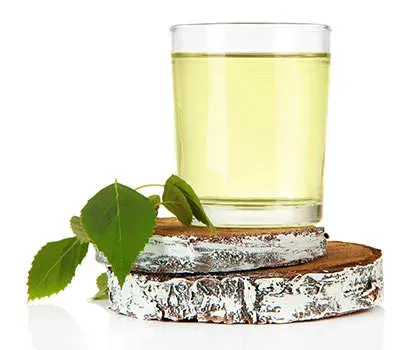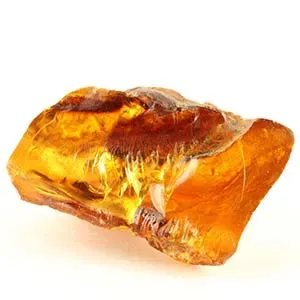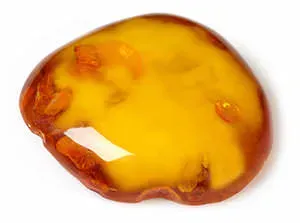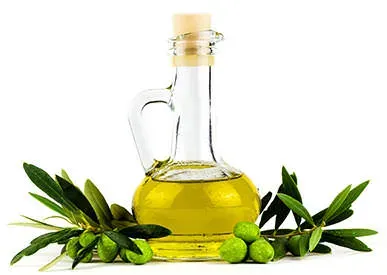 Amber is actually not a stone, but rather amorphous, fossilized tree sap. Amber comes from the fossilized resin that lived tens of millions of years ago in trees. It is normally a golden yellow to golden orange, and ranges from transparent to semi translucent. It can also be dyed many colors. Amber was one of the first substances used for personal adornment. In fact, decorated pieces of amber have been found in remains from the Stone Age. The stones were used as amulets and talismans before, during, and since the ancient Greeks. Amber rates a 2.5 on the hardness scale but is reasonably tenacious and workable- its softness makes it relatively easy to carve. Since prehistoric times, amber has been used for religious objects. It was believed to have talismanic properties, and many ancient people buried amber objects and amulets with their dead to protect them in the afterlife.
Amber is actually not a stone, but rather amorphous, fossilized tree sap. Amber comes from the fossilized resin that lived tens of millions of years ago in trees. It is normally a golden yellow to golden orange, and ranges from transparent to semi translucent. It can also be dyed many colors. Amber was one of the first substances used for personal adornment. In fact, decorated pieces of amber have been found in remains from the Stone Age. The stones were used as amulets and talismans before, during, and since the ancient Greeks. Amber rates a 2.5 on the hardness scale but is reasonably tenacious and workable- its softness makes it relatively easy to carve. Since prehistoric times, amber has been used for religious objects. It was believed to have talismanic properties, and many ancient people buried amber objects and amulets with their dead to protect them in the afterlife.
 The Romans called amber succinum, as it was rightly believed to be from tree sap. It was also used in the Neolithic times as an ornamental material. Amber was brought all the way to the Alps from the Baltic coast- a huge distance for those days, which gives us an idea of how important the stone was in that time. Amber is known for producing an electrical charge when rubbed. In fact, the Greek name for amber is electron, which the word electricity is derived from. Sacred to the sun god Apollo, amber was once thought to be congealed sunlight. Amber was also viewed as tears- for the Vikings, and for the Greeks, tears over the death of Phaeton.
The Romans called amber succinum, as it was rightly believed to be from tree sap. It was also used in the Neolithic times as an ornamental material. Amber was brought all the way to the Alps from the Baltic coast- a huge distance for those days, which gives us an idea of how important the stone was in that time. Amber is known for producing an electrical charge when rubbed. In fact, the Greek name for amber is electron, which the word electricity is derived from. Sacred to the sun god Apollo, amber was once thought to be congealed sunlight. Amber was also viewed as tears- for the Vikings, and for the Greeks, tears over the death of Phaeton.
 Amber may contain insects, (occasionally frogs and lizards too) moss, or pine needles that have been trapped for millions of years in the resin, since the resin was sticky. Air bubbles may give amber a cloudy appearance but heating in oil will take them away. The biggest deposits of amber are in the Baltic region, particularly along the coast of Poland. Amber is also found in the Dominican Republic, Mexico, France, Spain, Canada, Romania, Norway, Denmark, Germany, Burma, and Italy. Amber has medicinal uses attributed to it but is used nowadays primarily in jewelry. It has been imitated by synthetic resin, glass, and plastic. Amber has very low density. A true test as to whether or not you have a genuine piece of amber is to put it in a solution of kitchen salt and water. This is a common test to check amber as plastic will sink, and amber will float. A commonly encountered kind of amber is called "reconstructed amber," where small pieces of amber are compressed under heat to form a larger piece."
Amber may contain insects, (occasionally frogs and lizards too) moss, or pine needles that have been trapped for millions of years in the resin, since the resin was sticky. Air bubbles may give amber a cloudy appearance but heating in oil will take them away. The biggest deposits of amber are in the Baltic region, particularly along the coast of Poland. Amber is also found in the Dominican Republic, Mexico, France, Spain, Canada, Romania, Norway, Denmark, Germany, Burma, and Italy. Amber has medicinal uses attributed to it but is used nowadays primarily in jewelry. It has been imitated by synthetic resin, glass, and plastic. Amber has very low density. A true test as to whether or not you have a genuine piece of amber is to put it in a solution of kitchen salt and water. This is a common test to check amber as plastic will sink, and amber will float. A commonly encountered kind of amber is called "reconstructed amber," where small pieces of amber are compressed under heat to form a larger piece."
 Amber softens and starts to decompose at 150 degrees Fahrenheit and gives off a scent like the resin of pine trees. It has been used in the West, the Arab world, and the Far East, for carved items, figurines, pipe pieces, brooches, perfume bottles, and cigarette holders. Amber supposedly brings mental and emotional strength and is highly calming. The stone can be cleaned using warm water and a soft cloth. You can use the cloth to rub olive oil on it to restore the polish. Never use ultrasonic or steam cleaners to clean amber, as it will shatter. Also, never leave amber in direct sunlight, or any place where it might be exposed to sudden temperature changes or chemicals, as its finish will dull.
Amber softens and starts to decompose at 150 degrees Fahrenheit and gives off a scent like the resin of pine trees. It has been used in the West, the Arab world, and the Far East, for carved items, figurines, pipe pieces, brooches, perfume bottles, and cigarette holders. Amber supposedly brings mental and emotional strength and is highly calming. The stone can be cleaned using warm water and a soft cloth. You can use the cloth to rub olive oil on it to restore the polish. Never use ultrasonic or steam cleaners to clean amber, as it will shatter. Also, never leave amber in direct sunlight, or any place where it might be exposed to sudden temperature changes or chemicals, as its finish will dull.